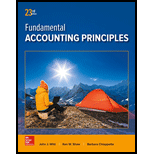
Concept explainers
Concept Introduction:
Asset:
An asset is a resource embodying an economic benefit that is owned and controlled by a business entity. The benefits derived from an asset are generally spread over the useful life of the asset. Assets can be tangible or intangible. In accounting, an asset is a real account and always shows debit balance.
Liability:
Liability is the obligation arising out of carrying business transactions that needs to be settled within a specified period of time. It is the sacrifice of economic benefits in future as the result of an obligation. Liabilities are classified as long term and short term. Liabilities represent real account and always show credit balance.
Equity:
Equity represents the ownership value of the business. In other words, the difference between assets and liabilities of a business is called equity. It is the net asset of an entity.
To determine: The assets, liabilities and equity accounts from the list of items
Want to see the full answer?
Check out a sample textbook solution
Chapter 2 Solutions
Fundamental Accounting Principles
- Please provide the solution to this general accounting question using proper accounting principles.arrow_forwardCan you solve this general accounting problem with appropriate steps and explanations?arrow_forwardKFC Industries estimates direct labor costs and manufacturing overhead costs for the upcoming year to be $920,000 and $740,000, respectively. KFC allocates overhead costs based on machine hours. The estimated total labor hours and machine hours for the coming year are 23,000 hours and 9,250 hours, respectively. What is the predetermined overhead allocation rate? (Round your answer to the nearest cent.) Help with this questionarrow_forward
- I need help finding the accurate solution to this general accounting problem with valid methods.arrow_forwardJeel Corporation projected current year sales of 45,000 units at a unit sale price of $32.00. Actual current year sales were 48,500 units at $34.50 per unit. Actual variable costs, budgeted at $22.50 per unit, totaled $21.75 per unit. Budgeted fixed costs totaled $375,000, while actual fixed costs amounted to $392,000. What is the sales volume variance for total revenue?arrow_forwardCan you help me solve this general accounting question using valid accounting techniques?arrow_forward

 AccountingAccountingISBN:9781337272094Author:WARREN, Carl S., Reeve, James M., Duchac, Jonathan E.Publisher:Cengage Learning,
AccountingAccountingISBN:9781337272094Author:WARREN, Carl S., Reeve, James M., Duchac, Jonathan E.Publisher:Cengage Learning, Accounting Information SystemsAccountingISBN:9781337619202Author:Hall, James A.Publisher:Cengage Learning,
Accounting Information SystemsAccountingISBN:9781337619202Author:Hall, James A.Publisher:Cengage Learning, Horngren's Cost Accounting: A Managerial Emphasis...AccountingISBN:9780134475585Author:Srikant M. Datar, Madhav V. RajanPublisher:PEARSON
Horngren's Cost Accounting: A Managerial Emphasis...AccountingISBN:9780134475585Author:Srikant M. Datar, Madhav V. RajanPublisher:PEARSON Intermediate AccountingAccountingISBN:9781259722660Author:J. David Spiceland, Mark W. Nelson, Wayne M ThomasPublisher:McGraw-Hill Education
Intermediate AccountingAccountingISBN:9781259722660Author:J. David Spiceland, Mark W. Nelson, Wayne M ThomasPublisher:McGraw-Hill Education Financial and Managerial AccountingAccountingISBN:9781259726705Author:John J Wild, Ken W. Shaw, Barbara Chiappetta Fundamental Accounting PrinciplesPublisher:McGraw-Hill Education
Financial and Managerial AccountingAccountingISBN:9781259726705Author:John J Wild, Ken W. Shaw, Barbara Chiappetta Fundamental Accounting PrinciplesPublisher:McGraw-Hill Education





